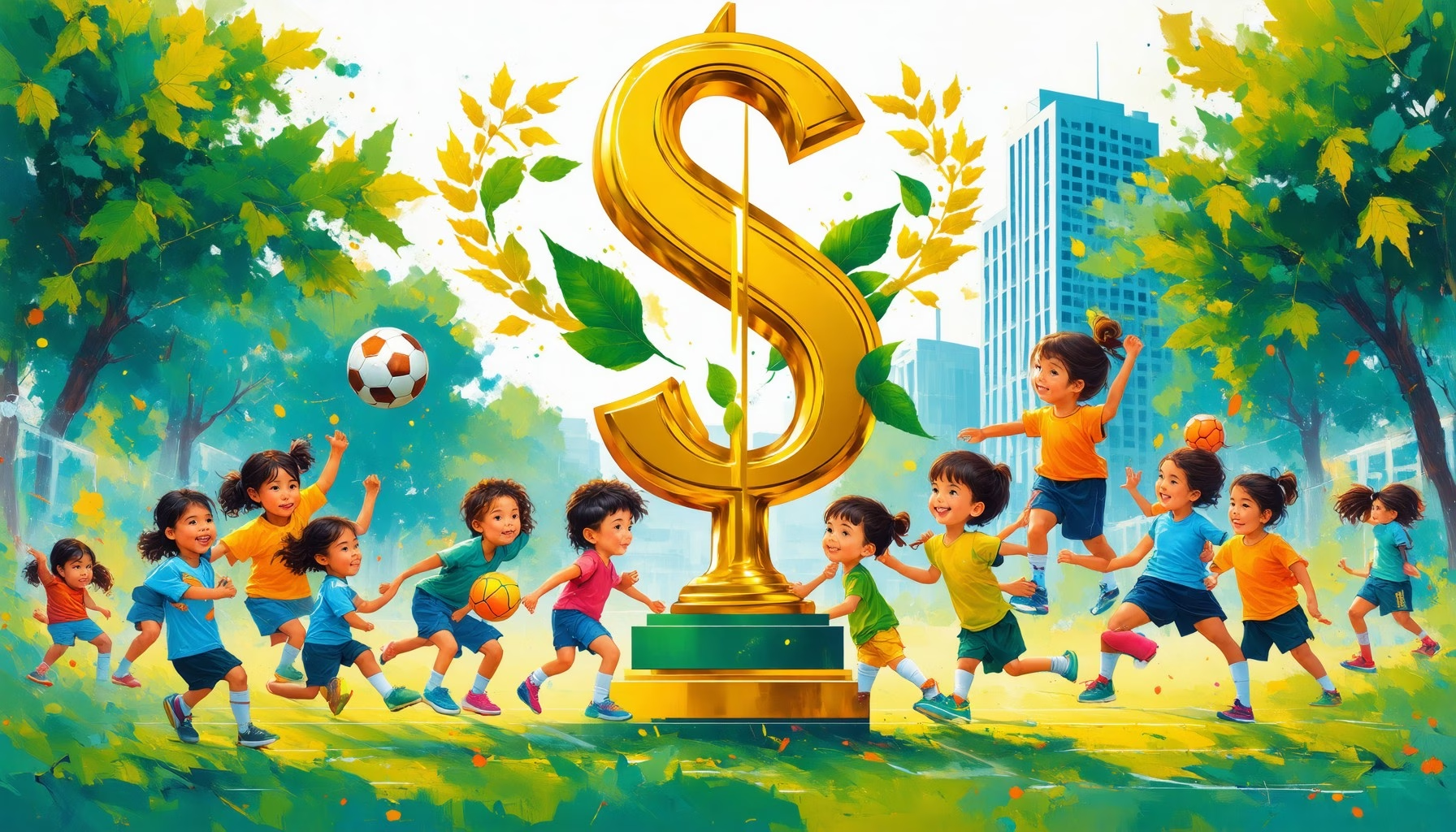Key Takeaways
- Discover essential government grants for sports programs to enhance youth athletics and community engagement.
- Learn how to effectively write a grant for sports with a strong proposal that stands out.
- Explore various funding sources, including federal grants for youth sports, state, and local options.
- Understand eligibility criteria for youth sports grants aimed at schools and community programs.
- Utilize online resources like Grants.gov for finding available funding opportunities.
- Engage your community to demonstrate support, which can significantly strengthen your grant applications.
- Stay informed about emerging trends in sports funding, including technology integration and inclusivity initiatives.
In today’s competitive landscape, securing government grants for sports programs has become essential for fostering youth athletics and enhancing community engagement through sports. This essential guide will delve into the various avenues available for obtaining grant money for youth sports, including insights on how to get grants for school sports and the types of funding options that exist for athletic facilities. We will explore whether the government funds sports, highlighting federal grants for youth sports programs and what you need to know to navigate this complex landscape. Additionally, we will provide practical tips on how to write a grant for sports, ensuring your proposal stands out in a competitive field. Whether you are looking to fund a sports complex or support individual athletes, this article will equip you with the knowledge to successfully secure youth sports grants and other funding opportunities. Join us as we uncover the essential steps to accessing grants for youth athletics and the resources available to help you achieve your sports program goals.
How to get grants for school sports?
Understanding the Basics of Government Grants for Sports Programs
To secure grants for school sports, consider the following comprehensive strategies:
1. **Identify Grant Opportunities**: Research various funding sources that support youth sports initiatives. Key organizations include:
– **Youth Sports Grants**: Programs like All Kids Play offer funding specifically for non-profit organizations and school sports programs.
– **Government Grants**: Check local, state, and federal government websites for grants aimed at enhancing community sports programs. Websites like Grants.gov provide a searchable database of available grants.
2. **Eligibility Requirements**: Ensure your organization meets the eligibility criteria. Typically, grants are available for:
– Non-profit organizations
– School sports programs
– Government-run programs in low-income communities
– Programs serving children in grades K-12
3. **Develop a Strong Proposal**: Craft a compelling grant proposal that includes:
– A clear mission statement outlining the goals of your sports program
– Detailed descriptions of the target community and the impact of your program
– A budget that outlines how the funds will be used effectively
4. **Engage the Community**: Demonstrate community support by:
– Involving local stakeholders, such as parents, schools, and community leaders
– Collecting letters of support or endorsements from community members
5. **Follow Application Guidelines**: Adhere strictly to the application guidelines provided by the grantor. This includes formatting, deadlines, and required documentation.
6. **Utilize Online Resources**: Leverage platforms like Gov Guider to find additional resources and guidance on navigating the grant application process.
7. **Network and Collaborate**: Connect with other organizations that have successfully obtained grants. They can provide insights and tips on best practices.
By following these steps and focusing on building a strong case for funding, your organization can enhance its chances of receiving grants for school sports programs. For further information, refer to authoritative sources such as the National Recreation and Park Association (NRPA) and the U.S. Department of Education’s resources on funding for school sports.
Types of Grants Available for Youth Sports Programs
When exploring funding options for youth sports, it’s essential to understand the various types of grants available. These can be categorized into several key areas:
1. **Federal Grants for Sports Programs**: The federal government offers a range of grants aimed at promoting youth sports. These grants often focus on improving access to sports for underprivileged communities and enhancing physical education programs in schools. Examples include government grants for youth sports and federal grants for youth sports programs.
2. **State and Local Grants**: Many states and local governments provide grants specifically for youth sports initiatives. These grants can vary widely in terms of eligibility and funding amounts. It’s crucial to check with your state’s department of education or local sports councils for available opportunities.
3. **Private and Non-Profit Grants**: Numerous private organizations and non-profits offer grants for youth athletics. These grants may focus on specific sports, community engagement, or promoting health and wellness among youth. Organizations like the USA.gov can help identify relevant private funding sources.
4. **Corporate Sponsorships and Grants**: Some corporations provide funding for youth sports programs as part of their corporate social responsibility initiatives. These grants can be competitive but often come with additional resources, such as equipment donations or volunteer support.
By understanding the types of grants available, organizations can better position themselves to secure funding for youth sports programs, ultimately enhancing opportunities for young athletes.

Does the Government Fund Sports?
The government does provide various forms of funding and support for sports, though the structure and extent of this funding can vary significantly between federal, state, and local levels.
Overview of Government Funding for Sports Programs
The federal government does not directly fund the U.S. Olympic Committee or Olympic sports, which is a notable difference compared to many other countries. However, it indirectly supports sports through legislation such as Title IX, which mandates equal opportunities for women in sports at educational institutions receiving federal funding. This law has significantly increased female participation in sports at all levels.
Additionally, the federal government facilitates local and state governments in issuing tax-exempt bonds for the construction of sports facilities, which can benefit professional sports teams and enhance community sports infrastructure. State and local governments play a crucial role in funding sports, particularly for professional teams and public sports facilities. This funding often comes in the form of public subsidies for stadium construction, operational costs, and renovations.
Local governments may also provide grants for youth sports programs and community recreation facilities, which are essential for promoting sports at the grassroots level. According to a report by the National Conference of State Legislatures, many states have invested heavily in sports infrastructure to attract tourism and boost local economies.
Federal Grants for Youth Sports Programs: What You Need to Know
Various government entities offer grants specifically aimed at enhancing sports programs. These grants often focus on increasing youth participation, improving sports infrastructure, and promoting health and wellness through physical activity. For instance, the U.S. Department of Health and Human Services provides funding for programs that encourage physical activity among children and adolescents.
Beyond direct funding, governments provide indirect support through tax exemptions, infrastructure improvements, and policies that foster public-private partnerships for sports facility development. These initiatives can significantly reduce the financial burden on local governments while promoting sports and recreation in the community.
In summary, while the federal government does not directly fund Olympic sports, it plays a vital role in supporting sports through legislation and facilitating state and local funding. State and local governments are instrumental in providing financial resources for professional teams, community sports, and youth programs, ensuring a robust sports ecosystem across the nation.
How to Write a Grant for Sports?
Writing a successful grant for sports organizations requires a structured approach to enhance your proposal’s effectiveness and increase your chances of securing funding. Here’s a detailed guide on the key components to include in your grant application.
Key Components of a Successful Sports Grant Proposal
To write a successful grant for youth sports, follow these structured steps:
- Problem Statement: Clearly articulate the specific issue your sports program aims to address. Use data and statistics to support your claims. For example, if your program targets youth obesity, cite relevant studies from sources like the Centers for Disease Control and Prevention (CDC) that highlight the prevalence of obesity among children.
- Goals and Objectives: Define measurable goals that align with the problem statement. Use the SMART criteria (Specific, Measurable, Achievable, Relevant, Time-bound) to ensure clarity. For instance, “Increase youth participation in sports by 25% over the next year.”
- Methods: Describe the strategies and activities you will implement to achieve your objectives. Include details about training sessions, community outreach, and partnerships with local schools or organizations. Reference successful models from existing programs, such as those documented by the National Alliance for Youth Sports.
- Evaluation: Outline how you will assess the effectiveness of your program. Specify the metrics you will use, such as participant surveys, attendance records, and health outcomes. Citing methodologies from academic journals can strengthen this section, such as those found in the Journal of Sport Management.
- Program Sustainability: Discuss how you plan to maintain the program after the grant period ends. This could involve strategies for securing ongoing funding, community support, or partnerships. Highlight examples of sustainable practices from other sports initiatives.
- Budget: Provide a detailed budget that outlines all projected expenses and funding sources. Ensure that your budget aligns with the goals and methods outlined in your proposal. Use templates from reputable sources like the Foundation Center to ensure accuracy.
- Background Section: Include a brief overview of your organization, its mission, and past successes. This establishes credibility and demonstrates your capacity to manage the proposed project.
- Summary and Cover Letter: Conclude with a compelling summary that reiterates the importance of your project and its potential impact. The cover letter should be concise, engaging, and tailored to the specific grantor, emphasizing why your project aligns with their funding priorities.
For additional resources, consider utilizing platforms like Gov Guider, which provides guidance on federal grant opportunities and best practices for grant writing. By following these steps and incorporating authoritative sources, your grant proposal will be more comprehensive, persuasive, and likely to succeed in securing funding.
Tips for Writing Effective Grant Applications for Youth Sports
To enhance your chances of receiving grant money for youth sports, consider the following tips:
- Research Funding Sources: Identify potential federal grants for sports programs and local funding opportunities. Understanding the priorities of grantors can help tailor your proposal accordingly.
- Engage Stakeholders: Involve community members, parents, and local businesses in your proposal process. Their support can strengthen your application and demonstrate community backing.
- Use Clear and Concise Language: Avoid jargon and ensure your proposal is easy to read. Clear communication increases the likelihood that reviewers will understand and appreciate your project.
- Proofread and Edit: Ensure your application is free from errors. A polished proposal reflects professionalism and attention to detail, which can positively influence funding decisions.
- Follow Guidelines: Adhere strictly to the application guidelines provided by the funding agency. This includes formatting, required documents, and submission deadlines.
By implementing these tips and focusing on the essential components of your proposal, you can significantly improve your chances of securing youth sports grants and making a positive impact in your community.
How to Get Funding for a Sports Complex?
Securing funding for a sports complex involves a multifaceted approach that combines various strategies to attract financial support. Understanding the different avenues available can significantly enhance your chances of success. Here are some effective methods to consider:
Exploring Funding Options for Building Sports Complexes
To secure funding for the construction of a sports complex, consider the following comprehensive strategies:
- Sponsorship Deals: Engage local businesses and corporations to establish sponsorship agreements. This can include selling naming rights for the facility or specific areas within it, which can provide significant upfront capital. Research shows that effective sponsorship can enhance brand visibility while supporting community initiatives.
- Private Donations: Approach wealthy individuals or philanthropic organizations interested in supporting community development through sports. Building relationships with potential donors can lead to substantial contributions. Highlight the benefits of the sports complex for local youth and community engagement to attract donations.
- Business Plan Development: Create a robust business plan that outlines the projected financials, community impact, and operational strategies for the sports complex. A well-structured plan is essential for securing bank loans or attracting private investors. According to the Small Business Administration, a detailed business plan increases the likelihood of obtaining funding.
- Fundraising Events: Organize community fundraising events such as charity tournaments, auctions, or fun runs. These events not only raise money but also increase community awareness and support for the sports complex project. Engaging the community can foster a sense of ownership and encourage further contributions.
- Grants and Government Funding: Explore federal, state, and local government grants specifically aimed at community development and sports facilities. Websites like Grants.gov provide a comprehensive database of available funding opportunities. Additionally, programs such as the Land and Water Conservation Fund (LWCF) can offer financial assistance for recreational projects.
- Crowdfunding: Utilize online crowdfunding platforms to reach a broader audience. This method allows individuals to contribute small amounts, which can accumulate to significant funding. Highlight the community benefits and potential impact of the sports complex to encourage participation.
Government Grants for Athletic Facilities: A Comprehensive Guide
Government grants for athletic facilities are a vital resource for those looking to build or enhance sports complexes. These grants can provide substantial financial support, making it easier to realize your vision. Here’s what you need to know:
- Types of Grants Available: Various federal grants for sports programs are available, including those specifically designed for youth sports and community athletic facilities. Understanding the eligibility criteria and application process is crucial for success.
- Application Process: When applying for government grants, ensure that your proposal clearly outlines the purpose of the funding, the expected community benefits, and how the facility will be maintained. A well-prepared application can significantly increase your chances of receiving grant money for youth sports.
- Resources for Finding Grants: Utilize online platforms such as USA.gov and U.S. Small Business Administration to find relevant grants for sports facilities. These resources can guide you through the process of identifying and applying for available funding.

How Do Athletes Get Funding?
Athletes can secure funding through various sources, which are crucial for supporting their training, competition, and development. Here are the primary avenues for funding:
- National Governing Bodies of Sport (NGBs): Many NGBs provide financial assistance in the form of grants or scholarships for young and emerging athletes. Each sport has its own governing body, and athletes can find specific funding opportunities by visiting the respective NGB’s website.
- Sports Aid Foundation: This organization offers financial support to talented athletes, helping them cover costs associated with training and competition. Athletes can apply for grants that are tailored to their individual needs and circumstances.
- Active Partnerships: These regional organizations often allocate small grants to support local athletes. They focus on promoting sports and physical activity within communities and can be a valuable resource for funding.
- Corporate Sponsorships: Many athletes seek sponsorship from businesses that align with their sport or personal brand. These partnerships can provide significant financial backing, as companies often look to enhance their visibility through athlete endorsements.
- Crowdfunding: Platforms like GoFundMe allow athletes to raise funds directly from supporters. This method has gained popularity, especially for athletes who may not have access to traditional funding sources.
- Government Grants and Programs: Various government initiatives support sports development at different levels. Athletes can explore programs that provide financial assistance for training and competition expenses.
- Scholarships from Educational Institutions: Many colleges and universities offer athletic scholarships to recruit talented athletes. These scholarships can cover tuition, housing, and other expenses, allowing athletes to focus on their sport while pursuing their education.
Grants for Youth Athletics: Supporting Young Talent
Grants for youth athletics play a vital role in nurturing young talent and ensuring that financial barriers do not hinder participation in sports. These grants can come from various sources, including:
- Federal Grants for Youth Sports Programs: The government provides federal grants for youth sports programs aimed at enhancing athletic opportunities for young individuals.
- Local Community Grants: Many local governments and organizations offer sports grants for youth to promote community engagement and physical activity.
- Nonprofit Organizations: Various nonprofits focus on providing grants for youth sports to support programs that encourage participation and skill development.
Who Pays for School Grants?
Understanding the sources of funding for school grants is crucial for accessing financial support for youth sports programs. Grants for education are primarily funded by the federal government, state governments, and various private organizations. Here’s a detailed breakdown of who pays for school grants:
- Federal Government: The U.S. Department of Education administers several federal grant programs, including the Pell Grant, which is awarded to low-income undergraduate students. According to the Federal Student Aid website, these grants do not require repayment, making them a vital resource for many students.
- State Governments: Many states offer their own grant programs to support residents attending college or vocational schools. These state grants often target specific demographics, such as low-income students or those pursuing high-demand fields. For example, the California Cal Grant program provides financial assistance to eligible students attending college in California.
- Private Organizations and Foundations: Numerous non-profit organizations, corporations, and foundations provide grants to students based on various criteria, including academic achievement, field of study, or community service. Examples include the Gates Millennium Scholars Program and the Jack Kent Cooke Foundation, which aim to support high-achieving students from low-income backgrounds.
- Colleges and Universities: Many institutions also offer their own grants, often funded by alumni donations or institutional resources. These grants may be based on merit, need, or specific programs within the school.
In summary, school grants are funded by a combination of federal and state governments, private organizations, and educational institutions, providing essential financial support to students pursuing higher education. For more information on available grants, students can visit the Federal Student Aid website or their state’s education department.
The Role of Nonprofits and Corporations in Youth Sports Grants
Nonprofits and corporations play a significant role in funding youth sports programs through various grants. These organizations often recognize the importance of physical activity and teamwork in youth development and provide financial support to enhance sports opportunities for children. Here are some key aspects of their contributions:
- Grant Programs: Many nonprofits, such as the YMCA and Sports Matter, offer grants specifically aimed at funding youth sports initiatives. These grants can cover equipment, facility improvements, and coaching expenses.
- Corporate Sponsorships: Corporations often sponsor youth sports teams or events, providing funding in exchange for brand visibility. This sponsorship can include monetary donations or in-kind contributions, such as sports gear or promotional materials.
- Community Engagement: Nonprofits and corporations frequently engage with local communities to identify specific needs in youth sports. By collaborating with schools and community organizations, they can tailor their funding efforts to maximize impact.
Overall, the involvement of nonprofits and corporations in youth sports grants is essential for fostering athletic opportunities and promoting healthy lifestyles among young people. For more information on available funding options, you can explore resources like Gov Guider.
Conclusion: Navigating the Landscape of Government Grants for Sports Programs
Future Trends in Grants for Youth Sports Programs 2024
As we look ahead to 2024, the landscape of government grants for youth sports programs is evolving. Increased emphasis on health and wellness among youth has led to a surge in funding opportunities. Federal grants for youth sports programs are expected to expand, with a focus on promoting inclusivity and accessibility. Programs that cater to underrepresented communities will likely see more support, as government initiatives aim to bridge the gap in youth athletics.
Additionally, technology integration in sports programs is gaining traction. Grants for athletic facilities that incorporate modern technology for training and development are becoming more prevalent. This trend not only enhances the training experience but also attracts funding aimed at improving overall athletic performance. As a result, organizations should stay informed about upcoming federal grants for sports programs that align with these innovative approaches.
Resources for Finding Government Grants for Sports Programs Near Me
Finding government grants for sports programs can be simplified by utilizing various resources. Websites like [Grants.gov](https://www.grants.gov/) provide a comprehensive database of available grants, including those specifically for youth sports. Additionally, local government websites often list funding opportunities tailored to community needs, including grants for youth athletics and sports facility grants.
Nonprofit organizations and community foundations are also valuable resources for discovering grants for youth sports programs. They frequently offer funding for programs that promote physical activity and community engagement. For example, organizations focused on youth development may provide grants for sports teams or athletic fields.
To further enhance your search, consider using platforms like [USA.gov](https://www.usa.gov/) to access information about federal and state funding opportunities. By leveraging these resources, you can effectively navigate the landscape of grants for youth sports and secure the necessary funding to support your programs.




